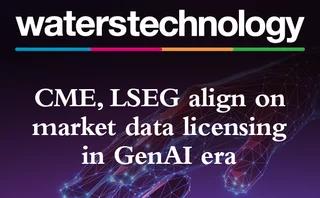Audit Trail or Snail Trail?

How much is avoiding another ‘Flash Crash’ worth? That’s the question US market participants are asking as they respond to the Securities and Exchange Commission’s (SEC) proposed real-time consolidated audit trail of trading activity across equity and options markets to spot anomalies and potential abuse.
“The information in the consolidated audit trail might give earlier indications on the state of the markets, generating warnings of impending problems such as the Flash Crash,” says Stephen Elston, managing director of Quantia Analytics, whose analysis of May 6 shows monitoring market activity in real-time would have generated warnings more than a minute before the worst of the crash in some stocks.
However, the proposal has met with a mixed reception from the markets. For example, Finra (the Financial Industry Regulatory Authority)—which already produces the Oats (Order Audit Trail) and Trace consolidated trade feeds, and would be a key component in any solution—says the SEC “significantly overvalued the regulatory benefits” of real-time reporting, and that real-time data is less reliable than corrected and validated information.
Wells Fargo Advisors echoed this, saying real-time reporting “inhibits” detection of fraudulent or manipulative activity, since “accurate market information often does not happen in real time,” but “only ‘settles down’ in a period after the real-time execution.”
But to be able to monitor for more than just suspicious activity—for example, to detect a systemic problem and take action in real-time—the SEC needs raw, un-corrected data to see exactly what caused actions at a point in time. Once data is validated and corrected after the fact, it can become harder to detect the cause of an incident.
“You don’t just need feeds, a ticker plant and databases… you also need to be able to look at these in real time and spot patterns of behavior that indicate something is going awry—from a trader trying to manipulate the market to an issue with a trading application submitting a lot of orders in a short time, which might indicate an algo trading system going wrong,” says Giles Nelson, deputy chief technology officer at Progress Software.
Wells Fargo was also concerned that the 32-month estimated schedule for implementation would be “woefully short,” and that “rushing through such a dramatic change… poses a great risk of harm,” resulting from a lack of vetting and stress-testing, suggesting a five-year plan would be more realistic.
Among the plan’s supporters, new exchange Direct Edge said it “would significantly enhance the capabilities of regulators to police trading across asset classes… [and] create a more complete timeline of an order’s lifecycle,” while TD Ameritrade called it “the right solution and… overdue,” but estimated its initial spend to support its contributions to a system would be $1.25 million, including $750,000 in development and $500,000 for hardware, and would require three full-time staff.
Many said the industry-wide costs required to implement a consolidated audit trail—estimated by the SEC at around $4 billion, with ongoing annual costs of around $2.1 billion—are too high, though others believe a system can be achieved for much less.
In fact, a consortium calling itself TickLab—comprising data architecture consultancy Noetic Partners, data vendor Activ Financial and high-performance computing technology vendors Cray Research and XtremeData—has proposed that it can build a system that includes full-depth tick data capture and high-performance storage for fast retrieval for less than $100 million, which would cost less than $100 million per year to run.
So, how much is an orderly market worth? Those who believe lightning never strikes the same place twice might say the benefits aren’t worth the cost. But lightning always strikes again somewhere, and—as the saying goes—those who don’t learn from the past are doomed to repeat it.
Only users who have a paid subscription or are part of a corporate subscription are able to print or copy content.
To access these options, along with all other subscription benefits, please contact info@waterstechnology.com or view our subscription options here: https://subscriptions.waterstechnology.com/subscribe
You are currently unable to print this content. Please contact info@waterstechnology.com to find out more.
You are currently unable to copy this content. Please contact info@waterstechnology.com to find out more.
Copyright Infopro Digital Limited. All rights reserved.
As outlined in our terms and conditions, https://www.infopro-digital.com/terms-and-conditions/subscriptions/ (point 2.4), printing is limited to a single copy.
If you would like to purchase additional rights please email info@waterstechnology.com
Copyright Infopro Digital Limited. All rights reserved.
You may share this content using our article tools. As outlined in our terms and conditions, https://www.infopro-digital.com/terms-and-conditions/subscriptions/ (clause 2.4), an Authorised User may only make one copy of the materials for their own personal use. You must also comply with the restrictions in clause 2.5.
If you would like to purchase additional rights please email info@waterstechnology.com
More on Trading Tech
Will overnight trading in equity markets expand next year? It’s complicated.
The potential for expanded overnight trading in US equity markets sparked debate this year, whether people liked it or not.
WatersTechnology latest edition
Check out our latest edition, plus more than 13 years of our best content.
The total portfolio approach gains momentum: Building the right tech foundation for success
The rationale for the TPA, and the crucial role technology plays in enabling such an approach
Google, CME say they’ve proved cloud can support HFT—now what?
After demonstrating in September that ultra-low-latency trading can be facilitated in the cloud, the exchange and tech giant are hoping to see barriers to entry come down.
Institutional priorities in multi-asset investing
Private markets, broader exposures and the race for integration
BlackRock and AccessFintech partner, LSEG collabs with OpenAI, Apex launches Pisces service, and more
The Waters Cooler: CJC launches MDC service, Centreon secures Sixth Street investment, UK bond CT update, and more in this week’s news roundup.
TCB Data-Broadhead pairing highlights challenges of market data management
Waters Wrap: The vendors are hoping that blending TCB’s reporting infrastructure with Broadhead’s DLT-backed digital contract and auditing engine will be the cure for data rights management.
Robeco tests credit tool built in Bloomberg’s Python platform
This follows the asset manager’s participation in Bloomberg’s Code Crunch hackathon in Singapore, alongside other firms including LGT Investment Bank and university students.








